steering wheel adjustment AUDI A4 CABRIOLET 2009 Owners Manual
[x] Cancel search | Manufacturer: AUDI, Model Year: 2009, Model line: A4 CABRIOLET, Model: AUDI A4 CABRIOLET 2009Pages: 340, PDF Size: 77.32 MB
Page 94 of 340
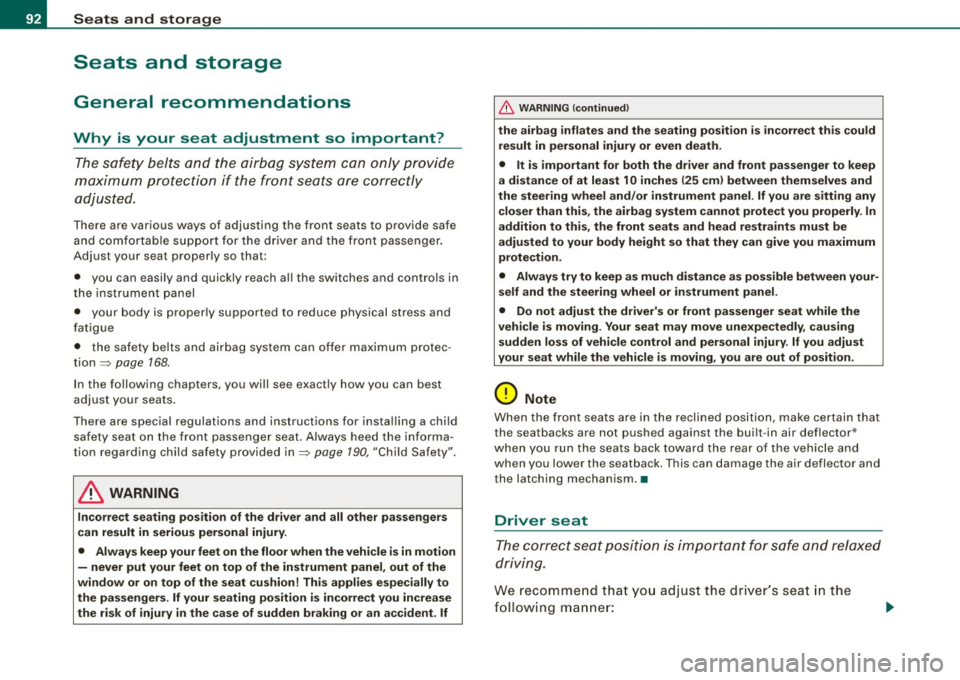
Seats and storage
Seats and storage
General recommendations
Why is your seat adjustment so important?
The safety belts and the airbag system can only provide
ma ximum protection if the front
seats are correctly
a djusted.
There are var ious ways of adjusting the front seats to provide safe
and c omfortable support for the driver and the front passenger.
Adjust your seat properly so that:
• you can easily and quickly reach all the switches and controls in
the instrumen t pa nel
• your body is proper ly supported to reduce physical stress and
f atigue
• the safety belts and airbag system can offe r maximum protec
tion=>
page 768.
I n the fo llowing chapters, you wil l see exact ly how you can best
adjust your seats.
There are special regulations and instructions for instal ling a child
safety seat on the front passenger seat. A lways heed the informa
tion regarding child safety provided in=>
page 790, "Child Safety".
& WARNING
Inco rrect se ating po sition of the driver a nd all other pa ssengers
c an result in serious per sonal injury.
• Alway s keep your feet on the floo r when the vehi cle is in motion
- never put your feet on top of the in strument panel , out of the
window o r on top of the seat cushio n! This appl ies espe ciall y to
the pa ssenger s. If your seating position i s incorre ct you increase
the ri sk of inju ry in the c ase of sudden br aking or an accident .
If
& WARNIN G (continued )
the airb ag inflate s and the seating position is incorre ct thi s could
r e sult in per sonal injury or even death.
• It is important for both the driver and front p assenger to keep
a distan ce of at least 10 inche s (25 cm) betw een them se lve s and
the steering wheel and /or in strument p anel . If you are sitting any
closer than this , the airbag system cannot protect you properly . In
a ddition to this , the front se ats and head re str aints mu st be
adjusted to your body height so th at they can give you maximum
protection .
• Alway s try to keep as much distan ce as possible between your
s elf and the steerin g wheel or in strument p anel.
• Do not adjust the driver's or front pas senger seat while the
vehicle is mov ing . You r seat may mo ve unexpect edly , ca usin g
s udden los s of vehicle control and per sonal injury.
If you adjust
your seat while the vehi cle i s moving , you a re out of position .
0 Note
When the front seats are in the reclined position, make certain that
the seatbacks are not pushed against the built -in air deflector *
when you run the sea ts back toward the rear of the vehicle and
when you lower the seatback. This can damage the air deflector and
the latching mecha nis m. •
Driver seat
The correct seat position is importan t for safe and relaxed
drivin g.
We recomme nd tha t yo u adjust the dr iv e r's sea t in the
fol lowing ma nne r:
Page 95 of 340
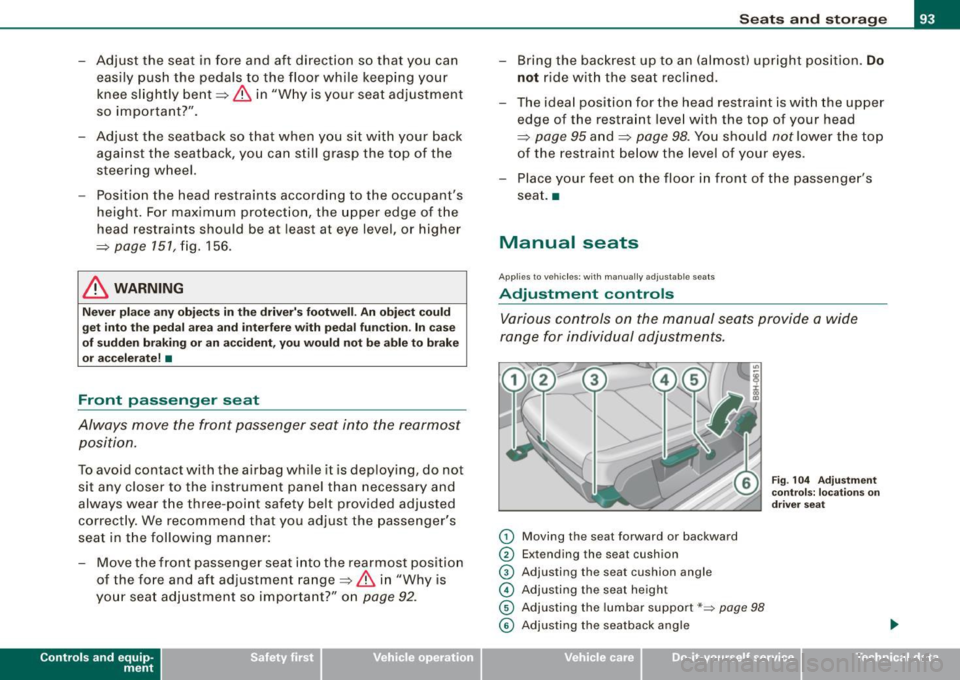
- Adjust the seat in fore and aft direction so that you can
easily push the pedals to the floor while keeping your
knee slightly bent==>
& in "Why is your seat adjustment
so important?".
- Adjust the seatback so that when you sit with your back against the seatback, you can still grasp the top of the
steering wheel.
- Position the head restraints according to the occupant's
height. For maximum protection, the upper edge of the
head restraints should be at least at eye level, or higher
==>
page 757,fig.156.
& WARNING
Never place any objects in the driver's footwell. An object could
get into the pedal area and interfere with pedal function. In case
of sudden braking or an accident, you would not be able to brake
or accelerate! •
Front passenger seat
Always move the front passenger seat into the rearmost
position.
To avoid contact with the airbag while it is deploying, do not
sit any closer to the instrument panel than necessary and
always wear the three-point safety belt provided adjusted
correctly. We recommend that you adjust the passenger's
seat in the following manner:
- Move the front passenger seat into the rearmost position
of the fore and aft adjustment range ==>
& in "W hy is
your seat adjustment so important?" on
page 92.
Controls and eq uip
ment
Seats and storage
- Bring the backrest up to an (almost) upright position . Do
not ride with the seat reclined.
- The ideal position for the head restra int is with the upper
edge of the restraint level with the top of your head
==>
page 95 and ==> page 98. You should not lower the top
of the rest ra int below the level of your eyes.
- Place your feet on the floor in front of the passenger's
seat. •
Manual seats
Applies to veh ic les: with manua lly adjustab le seats
Adjustment controls
Various controls on the manual seats provide a wide
range for individual adjustments.
0 Moving the seat forward or backward
0 Extending the seat cushion
© Adjusting the seat cushion angle
© Adjusting the seat height
© Adjusting the lumbar support*~ page 98
Fig. 104 Adjustment
controls: locations on
driver seat
© Adjusting the seatback angle .,
~ehicle care irechnical data
Page 120 of 340
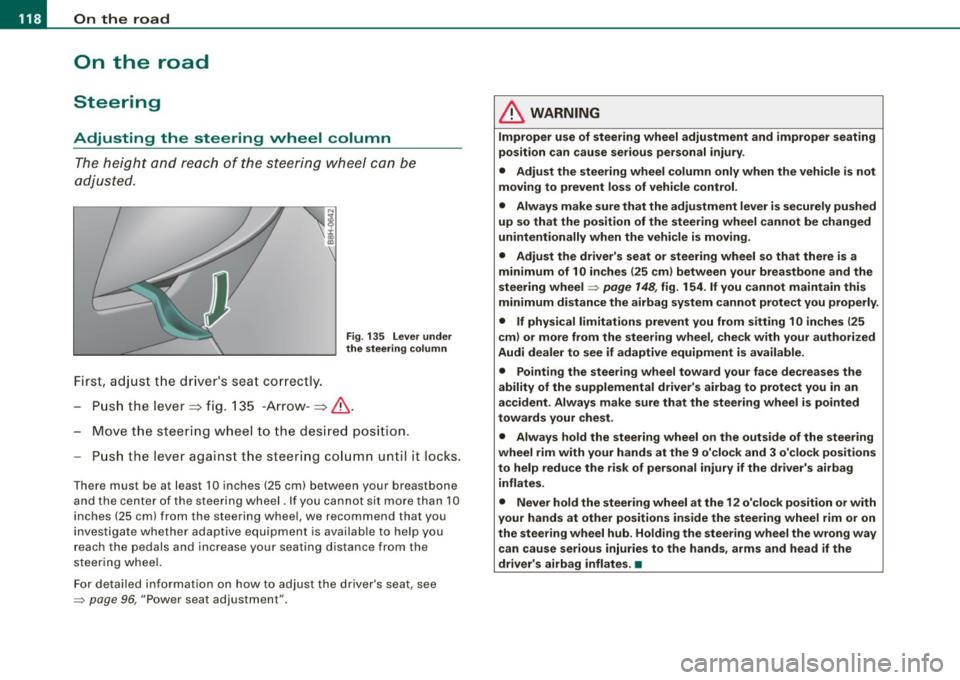
• .___O_ n_ t_h _e _ r_o _a_ d __________________________________________________ _
On the road
Steering
Adjusting the steering wheel column
The height and reach of the steering wheel can be
adjusted.
First, adjust the driver's seat correctly.
Fig . 135 Lever under
the steering column
-Push the lever~ fig. 135 -Arrow- ~& .
- Move the steering wheel to the desired position.
- Push the lever against the steering column unt il it locks.
Th ere mus t be at least 10 inches (25 cm) betw een your br eastbone
and the center of the steering wheel. If you cannot sit more than 10
inches (25 cm) from the steering wheel, we recommend that you
investigate whether adaptive equipment is available to help you
reach the pedals and increase your seating distance from the
steering wheel.
For detailed information on how to adjust the driver's seat, see
=> page 96, "Power seat adjustment" .
& WARNING
Improper use of steering wheel adjustment and improper seating
position can cause serious personal injury .
• Adjust the steering wheel column only when the vehicle is not
moving to prevent loss of vehicle control.
• Always make sure that the adjustment lever is securely pushed
up so that the position of the steering wheel cannot be changed
unintentionally when the vehicle is moving.
• Adjust the driver's seat or steering wheel so that there is a
minimum of 10 inches
125 cm) between your breastbone and the
steering wheel=> page 148, fig.
154. If you cannot maintain this
minimum distance the airbag system cannot protect you properly.
• If physical limitations prevent you from sitting 10 inches
125
cm) or more from the steering wheel, check with your authorized
Audi dealer to see if adaptive equipment is available.
• Pointing the steering wheel toward your face decreases the
ability of the supplemental driver's airbag to protect you in an
accident. Always make sure that the steering wheel is pointed
towards your chest.
• Always hold the steering wheel on the outside of the steering
wheel rim with your hands at the 9 o'clock and 3 o'clock positions
to help reduce the risk of personal injury if the driver's airbag
inflates.
• Never hold the steering wheel at the
12 o'clock position or with
your hands at other positions inside the steering wheel rim or on
the steering wheel hub. Holding the steering wheel the wrong way
can cause serious injuries to the hands, arms and head if the
driver's airbag inflates. •
Page 170 of 340
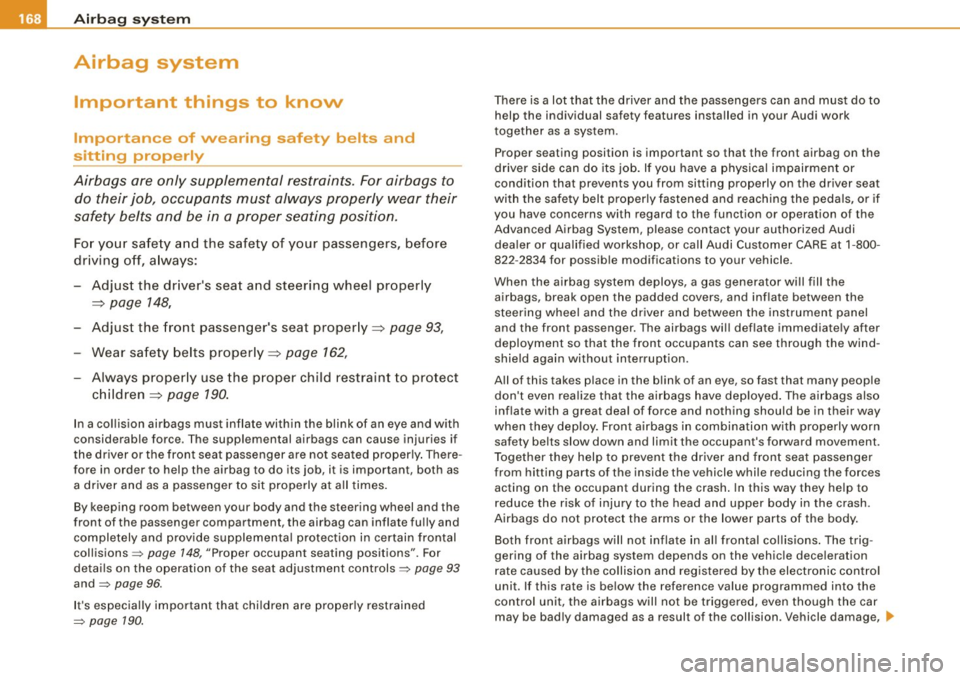
___ A_ ir_b _ a_ g~ s_ y_s _t _e _m _________________________________________________ _
Airbag system
Important things to know
Importance of wearing safety belts and
sitting properly
Airbags are only supplemental restraints. For airbags to
do their job, occupants must always properly wear their
safety belts and be in a proper seating position.
For your safety and the safety of your passengers, before
driving off, a lways:
- Adjust the driver's seat and steering wheel properly
=>
page 148,
- Adjust the front passenger's seat properly => page 93,
- Wear safety belts properly=> page 162,
- Always properly use the proper child restraint to protect
children=>
page 190 .
In a collision airbags must inflate within the blink of an eye and with
considerable force . Th e suppl emental airbags can caus e injuries if
the driver or the front seat passenger are not seated proper ly . There
fore in order to help the airbag to do its job, it is impor tant, both as
a driver and as a passenger to sit properly at all times.
By keeping room between your body and the steering wheel and the
front of the passenger compartment, the airbag can inflate fully and
completely and prov ide supplementa l protection in certain frontal
collisions ~
page 148, "Proper occupant seating positions" . For
details on the operation of the seat adjustment controls~
page 93
and ~ page 96.
It's especially important that chi ldren are proper ly restrained
~ page 190.
There is a lot that the driver and the passengers can and must do to
help the individual safety features installed in your Audi work
together as a system.
Proper seating posi tion is important so that the front airbag on the
driver side can do its job. If you have a physical impairment or
condition that prevents you from sitting properly on the driver seat
with the safety belt properly fastened and reaching the pedals, or if
you have concerns with regard to the function or operation of the
Advanced Airbag System, please contact your authorized Audi
dea ler or qua lif ied workshop, or call Audi Customer CARE at 1-800 -
822 -2834 for possible modifications to your vehicle .
When the airbag system deploys, a gas generator wi ll fill the
airbags, break open the padded covers, and inflate between the
steering wheel and the driver and between the instrument panel
and the front passenger. The airbags will deflate immediately after
deployment so that the front occupants can see through the wind
shield again without interruption .
All of this takes p lace in the blink of an eye, so fast that many people
don't even rea lize that the airbags have dep loyed. The airbags also
inflate with a great deal of force and nothing should be in their way
when they deploy . Front airbags in combination with properly worn
safety bel ts slow down and limit the occupant's forward movement.
Together they help to prevent the driver and front seat passenger
from hitting parts of the inside the vehicle while reducing the forces acting on the occupant during the crash . In this way they help to
reduce the risk of injury to the head and upper body in the crash .
Airbags do not protect the arms or the lower parts of the body.
Both front airbags w ill not in flate in al l frontal collisions . The trig
gering of the airbag system depends on the vehic le deceleration
rate caused by the collision and registered by the electronic contro l
unit. If this rate is below the reference value programmed into the
control unit, the airbags will not be triggered, even though the car
may be badly damaged as a result of the collision . Vehicle damage, .,
Page 177 of 340

Airbag system -----------------=~-
& WARNING (continued)
• If you must install a rearward facing child safety seat on the
front passenger seat because of exceptional circumstances and
the PASSENGER AIR BAG OFF light does not come on and stay on,
immediately install the rear -facing child safety seat in a rear
seating position and have the airbag system inspected by your
Audi dealer.
_& WARNING
If, in exceptional circumstances, you must install a forward-facing
child restraint on the front passenger's seat:
• Always make sure the forward-facing seat has been designed
and certified by its manufacturer for use on a front seat with a
passenger front and side airbag .
• Never put the forward-facing child restraint up against or very
near the instrument panel.
• Always move the passenger seat into its rearmost position in
the seat's fore and aft adjustment range, as far away from the
airbag as possible, before installing the forward-facing child
restraint. The backrest must be adjusted to an upright position.
• Make sure that the PASSENGER AIR BAG OFF light comes on
and stays on all the time whenever the ignition is switched on. •
Advanced Airbag System components
The front passenger seat in your vehicle has a lot of very important
parts of the Advanced Airbag System in it. These parts include the
weight-sensing mat, sensors, wiring, brackets, and more. The func
tion of the system in the front passenger seat is checked by the elec
tronic control unit when the ignition is on. The control unit monitors
the Advanced Airbag System and turns the airbag indicator light on
when a malfunction in the system components is detected. The
function of the airbag indicator light is described in greater detail
Controls and equip ment Safety first Vehicle operation
below.
Because the front passenger seat contains important parts
of the Advanced Airbag System, you must take care to prevent it
from being damaged. Damage to the seat may prevent the
Advanced Airbag for the front passenger seat from doing its job in
a crash.
The front Advanced Airbag System consists of the
following:
• Crash sensors in the front of the vehicle that measure vehicle
acceleration/deceleration to provide information to the Advanced
Airbag System about the severity of the crash.
• An electronic control unit, with integrated crash sensors for front
and side impacts. The control unit "decides" whether to fire the
front airbags based on the information received from the crash sensors. The control unit also "decides" whether the safety belt
pretensioners should be activated.
• An Advanced Airbag with gas generator for the driver inside the
steering wheel hub.
• An Advanced Airbag with gas generator inside the instrument
panel for the front passenger .
• A weight-sensing mat under the upholstery padding of the front
passenger seat cushion that measures the total weight on the seat.
The information registered is sent continuously to the electronic
control unit to regulate deployment of the front Advanced Airbag on
the passenger side.
• An airbag monitoring system and indicator light in the instru
ment cluster ~
page 179.
• The PASSENGER AIR BAG OFF light comes on and stays on in the
center of the instrument panel~
page 180, fig. 174 and tells you
when the front Advanced Airbag on the passenger side has been
turned off .
• A sensor below the safety belt latch for the front seat passenger
to measure the tension on the safety belt. The tension on the safety
belt and the weight registered by the weight -sensing mat help the
control unit "decide" whether the front airbag for the front _,.
Vehicle care Do-it-yourself service Technical data
Page 334 of 340
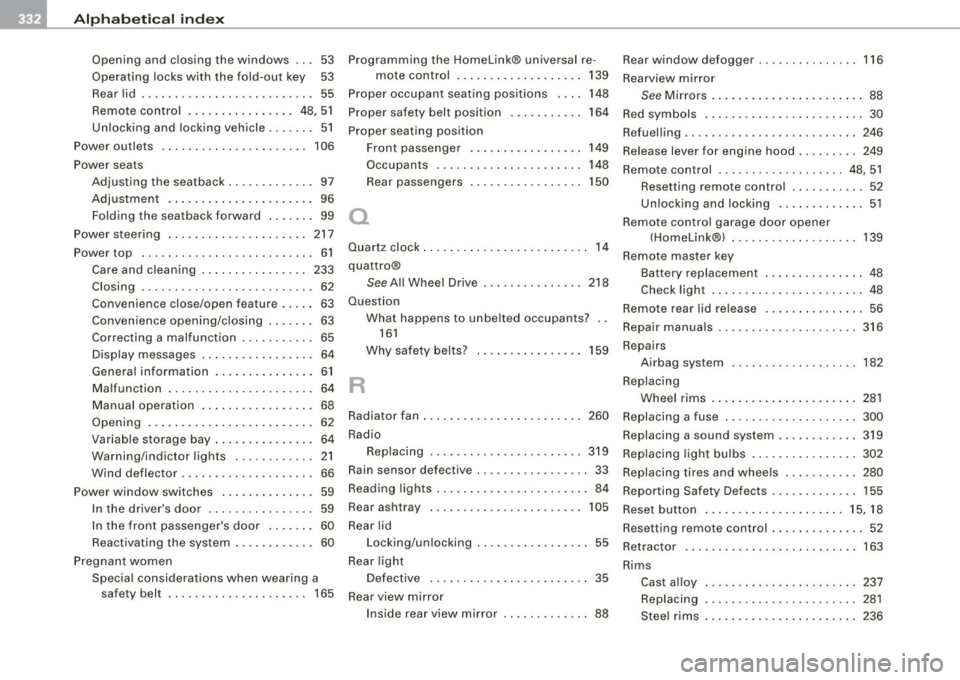
llffl _ __:._A..:.:IL: p :...:h..:.: a== b:..:e :...:t:.:..ic =-= a..:..l ..:..in :..:..:: d:...:e :.:x-=-----------------------------------------------
Opening and closing the windows 53
Operating locks with the fold-out key 53
Rear lid .......................... 55
Remote control ................ 48, 51
Un locking and locking vehicle ....... 51
Power outlets . . . . . . . . . . . . . . . . . . . . . . 106
Power seats Adjusting the seatback ............. 97
Adjustment . ...... .... .... .... ... 96
Folding the seatback forward ...... . 99
Power steering . . . . . . . . . . . . . . . . . . . . . 217
Power top . . . . . . . . . . . . . . . . . . . . . . . . . . 61
Care and cleaning ...... .... .. .... 233
Closing ........................ .. 62
Convenience close/open feature .. ... 63
Conven ience opening/closing ....... 63
Correcting a malfunct ion . . . . . . . . . . . 65
Display messages . . . . . . . . . . . . . . . . . 64
Genera l information . . . . . . . . . . . . . . . 61
Malfunction ...... ..... .. .... .... . 64
Manual operation . .... .... ...... .. 68
Opening ..................... .... 62
Variable storage bay . . . . . . . . . . . . . . . 64
Warning/indictor lights ........ .... 21
Wind deflector . . . . . . . . . . . . . . . . . . . . 66
Power window switches . . . . . . . . . . . . . . 59
In the driver's door ... .... ... ...... 59
In the front passenger's door . . . . . . . 60
Reactivating the system . . . . . . . . . . . . 60
Pregnant women Special considerations when wearing a safety belt . . . . . . . . . . . . . . . . . . . . . 165 Programming
the Homelink® universal re-
mote control . . . . . . . . . . . . . . . . . . . 139
Proper occupant seating positions .... 148
Proper safety belt position . . . . . . . . . . . 164
Proper seat ing position
Front passenger . . . . . . . . . . . . . . . . . 149
Occupants . . . . . . . . . . . . . . . . . . . . . . 148
Rear passengers 150
a
Quartz
clock . . . . . . . . . . . . . . . . . . . . . . . . . 14
quattro®
See All Wheel Drive ............... 218
Question
R
What happens to unbelted occupants? ..
161
Why safety belts? . . . . . . . . . . . . . . . . 159
Radiator fan ......... ............ ... 260
Radio Replacing . .... ... .... ........ ... 319
Rain sensor defective .. .... .... ....... 33
Reading lights .... ............. ...... 84
Rear ashtray . . . . . . . . . . . . . . . . . . . . . . . 105
Rear lid Locking/unlocking ............. ... . 55
Rear light
Defective ... .. ........ .... .... ... 35
Rear view mirror Inside rear view mirror .. .... ....... 88 Rear window defogger
..... .. ... .... . 116
Rearview mirror
See Mirrors ............ .... .... ... 88
Red symbols .. .... .... ... ........ ... 30
Refuelling .......................... 246
Release lever for engine hood ......... 249
Remote control ........ ...... .... . 48, 51
Resetting remote control ... .... .... 52
Un locking and locking . .... .... .... 51
Remote control garage door opener (Homelink®) ...... ... ..... .... . 139
Remote master key Battery replacement ..... ....... ... 48
Check light ....................... 48
Remote rear lid release ........... .... 56
Repair manuals ....... .... .... ...... 316
Repairs Airbag system
Replacing 182
Wheel rims ..... ................. 281
Replacing a fuse ...... .... .... ...... 300
Replacing a sound system .. .... ...... 319
Replacing light bulbs ...... .... .... .. 302
Replacing tires and wheels . ....... ... 280
Reporting Safety Defects ... .... ...... 155
Reset button . . . . . . . . . . . . . . . . . . . . . 15, 18
Resetting remote control ...... .... .... 52
Retractor . . . . . . . . . . . . . . . . . . . . . . . . . . 163
Rims Cast a lloy .. ........... .... ...... 237
Replacing .. ........... ........ .. 281
Stee l rims ...... .... ......... .... 236
Page 335 of 340
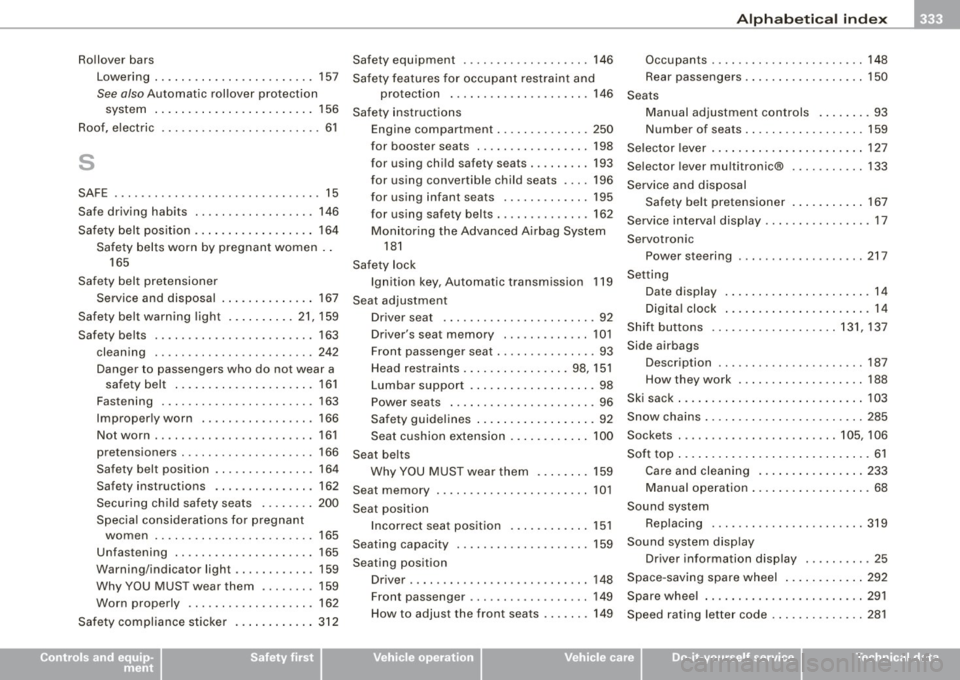
Alphabetical index -
-------------=----
Rollover bars
Lowering ... .. .... ....... ...... .. 157
See also Automatic rollover pro tection
system ... .. .... .... .... ... .... 156
Roof, e lectric ... .... .... .... ... .... .. 61
s
SAFE ...... ... .. .... .... ... .... .... . 15
Sa fe driv ing habits . ......... ....... . 146
Safety belt position .. ............. ... 164
Safety belts worn by pregnant women ..
165
Safety belt pretensioner Service and disposal . ..... .. ...... 167
Safety belt warning light .... .... .. 21,159
Sa fety be lts . . . . . . . . . . . . . . . . . . . . . . . . 163
cleaning ... .. ... ... .. ... ..... ... 242
Dange r to passengers who do not wear a
safety belt . . . . . . . . . . . . . . . . . . . . . 161
Fastening ... .... .... .... ... .... . 163
Improper ly worn . .... .... ...... .. 166
Not worn . ...... ........ ......... 161
pre tensioners ... .... .. ... .... .... 166
Safety bel t position .. .... .... .... . 164
Safety instructions ... ..... .. ... .. 162
Securing child safety seats . .... ... 200
Special considerations for pregnant
wom en . .... .... .... ... .... .... 165
Un fast ening . .... ... ..... .. .. ... . 165
Warning /indicator ligh t ..... ..... .. 159
Why YOU MUST wear them ........ 159
Worn properly .. ... ...... ... .... . 162
Safety compliance sticker .. ...... .... 312
Controls and equip
ment Safety first
Safety equipment
.... ....... .. .. .... 146 Occupants .... .... .... .... ..... .. 148
Safety features for occupant restraint and Rear passengers
... .... ...... .... . 150
pro tection . .... ...... .... ... .. . 146
Seats
Safe ty instructions Manual adjustment controls ........ 93
Eng in e compartm ent .. ... .... .... . 250 Number of seats .. .... .... .... .... 159
for booster seats . ...... .... ...... 198
Selector lever ............ .. . ..... ... 127
for using child safe ty s eats . .... .... 193
Selector lever multitronic ® ......... .. 133
for using convertible child sea ts .... 196
for using infant seats . ........... . 195
for using safety be lts . ...... .... ... 162
Monitoring the Advanced Airbag System
181 Service and
disposal
Safety belt pretensioner .. ..... .. .. 167
Service interval display .... ... .... ... .. 17
Servotron ic
Safety lock Ignition key, Automatic transmission 119
Seat adjustment Driver seat ... ...... ... .. .... ... .. 92
D river's seat memory . .......... .. 101
Front passenger seat . .... .... .... .. 93
Head restraints ................ 98, 151
Lumbar support . ...... ... .... .... . 98 Power steering
...... ............. 217
Setting Date display ............ .. ... ... .. 14
Digital clock ... .. .... .... .... .. .. . 14
Shift buttons .... .... .... ... .... 131, 137
Side airbags Description ... .... .... .. . .... .... 187
How they work .... ...... .... .... . 188
Power seats ... .. ........ .... .... . 96 Ski sack
... .............. ........... 103
Safety guidelines ... ... ....... .... . 92 Snow chains .
.... .... .... ... .... .... 285
Seat cushion extension ..... ... .... 100 Sockets
........... .... ... .. .... 105, 106
Seat belts Soft
top ... .. .... ....... .... .... ..... 61
Why YOU MUST wear them .... ... . 159 Care and cleaning
........ .... .. . . 233
Seat memory ....... ... .... .... .... . 101 Manual
operation ... ...... .... .. .. . 68
Seat position Sound system
Incorrect seat position .... .... .... 151 Replacing
.... .... .... ... .... .... 319
Seating capacity . ... .... .... .... .... 159 Sound system display
S eating position D
river information display . .... ..... 25
Driver .... .... ...... .... ... .. .... 148 Space
-saving spare wheel ... . ........ 292
Front passenger ......... ......... 149 Spare wheel ..
...... .... ... .... .... . 291
How to adjust the front sea ts .. .... . 149
Speed rat ing letter code ... ...... .... . 281
Vehicle operation Vehicle care Do-it-yourself service Technical data